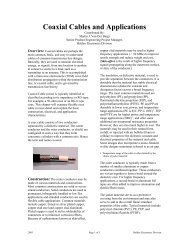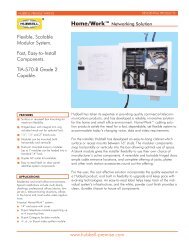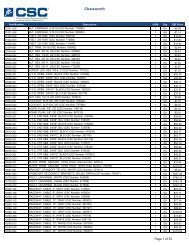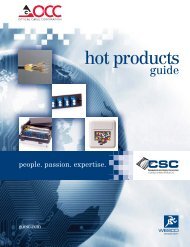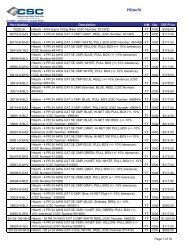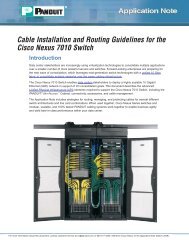SYSTIMAX® Building Automation Systems - Communications ...
SYSTIMAX® Building Automation Systems - Communications ...
SYSTIMAX® Building Automation Systems - Communications ...
Create successful ePaper yourself
Turn your PDF publications into a flip-book with our unique Google optimized e-Paper software.
SYSTIMAX ® <strong>Building</strong> <strong>Automation</strong> <strong>Systems</strong><br />
Cost Reducing Construction Techniques<br />
for New and Renovated <strong>Building</strong>s/Cost Models<br />
White Paper<br />
Issue 2<br />
March 2004<br />
SYSTIMAX ® Structured Connectivity Solutions<br />
www.systimax.com
WHITE PAPER BUILDING AUTOMATION SYSTEMS<br />
Contents<br />
1 Introduction 1<br />
2 The Foundation for <strong>Systems</strong> Integration 2<br />
3 Planning 4<br />
4 Integrating <strong>Building</strong> <strong>Automation</strong> <strong>Systems</strong> (BAS)<br />
with the Structured Cabling <strong>Systems</strong> for Voice and Data 7<br />
5 Bid Specifications 11<br />
6 Conclusion 12<br />
7 Cost Models 12
WHITE PAPER BUILDING AUTOMATION SYSTEMS<br />
1. Introduction<br />
There are many interpretations and definitions of an intelligent building. An intelligent building can be defined by<br />
the information and control services that meet the needs of the occupants, the software that controls<br />
telecommunications and building automation functions, or by the actual electronic hardware and devices<br />
implemented within the structure. It is necessary to have all of these components to create such a facility, but a<br />
Structured Connectivity Solution (SCS) is the common ingredient required to integrate the telecommunications<br />
(e.g., voice, data, video, etc.) and <strong>Building</strong> <strong>Automation</strong> <strong>Systems</strong> (BAS). Other than the SCS, these low voltage or<br />
power-limited services have nothing in common except similar transmission characteristics (i.e., analog or digital<br />
data signals), and the pathways (e.g., conduit, cable tray, raceway, and so on) that support and protect the<br />
cabling investment.<br />
Providing an internationally standardized SCS and consolidating the horizontal pathways for all the systems can<br />
reduce the initial construction costs by 10-15%, and up to 30%, for the cabling infrastructure of a modern<br />
intelligent building. The actual level of savings achieved is dependent upon the configuration and the geographical<br />
pricing for material and labor. An integrated systems approach also enables management to quickly and cost<br />
effectively respond to the changing needs of the tenants, which impacts the cost to occupy the space. In some<br />
cases, additional construction expenditures for the SCS or BAS, such as devices to optimize the use of power<br />
consumption, may be necessary to reduce the operational expenses. However, the costs for cabling-related changes<br />
can typically be reduced by 25-40% for a new or renovated facility when using a total systems integration approach.<br />
As can be seen from the graph below, typical costs for building operation and alterations over a 40-year life cycle<br />
far exceed the initial construction costs. Proper systems integration planning to optimize the construction process<br />
can reduce these on-going life cycle costs.<br />
Construction<br />
11%<br />
Operation<br />
50%<br />
Financing<br />
14%<br />
Alterations<br />
25%<br />
1
WHITE PAPER BUILDING AUTOMATION SYSTEMS<br />
2. The Foundation for <strong>Systems</strong> Integration<br />
For many years voice and data systems were cabled separately. Now it is standard practice to use a common<br />
SCS for both of these systems. Like the voice and data systems of the past, the traditional construction process<br />
separately installs each of the BAS disciplines under various divisions of a specification.<br />
The BAS typically consists of:<br />
• Fire, Life and Safety (FLS) or Fire Alarm (FA)<br />
• Security and Access Control (SAC)<br />
• Energy Management <strong>Systems</strong> (EMS), which includes Lighting Control<br />
• Heating, Ventilation and Air Conditioning (HVAC)<br />
Each of these BAS categories is typically cabled separately. The voice and data cabling is rarely addressed during<br />
construction and is usually not part of the construction budget. Planning and installation is normally accomplished<br />
when the floor space is being prepared for occupancy. This means multiple cabling systems and pathways are<br />
installed during various stages of the construction, which establishes one of the primary reasons for systems<br />
integration (i.e., integrated cabling and pathways instead of individual systems). Other reasons for integrating the<br />
BAS with the telecommunications include:<br />
• BAS use data networking and LAN architectures (i.e., intelligent controllers and addressable devices).<br />
Ethernet-IP based controllers are readily available from multiple BAS vendors.<br />
• BAS are increasingly being integrated into the primary data backbone, which allows controlled access<br />
through any PC on the data network.<br />
With proper planning the only limiting factor for complete systems integration of the telecommunications and BAS<br />
may be the fire alarm system. In the United States, Article 760-54 (b) of the 1999 National Electrical Code (NEC)<br />
allows conductors of power-limited fire alarm systems and signaling/communications circuits (Article 725/800) to<br />
share the same cable, enclosure, or raceway. In addition, Article 760-61 (d) of the NEC allows the use of the same<br />
type of cable for a fire alarm that is typically used for the communications circuits. Some local codes however,<br />
especially codes in other countries, may invoke limitations or require special approvals for integrating the fire alarm<br />
system. Yet, even if the fire alarm cabling is installed separately, there are still substantial cost reductions and<br />
benefits that can be derived from integrating the remaining BAS (i.e., HVAC, EMS, SAC).<br />
2
WHITE PAPER BUILDING AUTOMATION SYSTEMS<br />
In addition to the code and standards requirements, there is also a need to evaluate the electrical characteristics<br />
of the systems. The voice and data systems primarily consist of analog and digital signals, and have established<br />
guidelines for signal strength over distance. The BAS devices operate on current draw, circuit resistance (contact<br />
closure), or consist of analog or digital signals (e.g., communications bus). Basically, each BAS terminal or device<br />
will operate over a particular cable type as long as it is located within a specified range from the equipment.<br />
BAS devices are utilized to monitor or control a specific function. We can equate this to an output from the<br />
equipment or an input from a device. As an example, there may be a temperature sensor that gathers information<br />
and sends a signal to the equipment panel (input) and, as a consequence, the equipment sends a signal to a<br />
device that closes a damper or vent (output). Devices are primarily power-limited or communicate using lowspeed<br />
protocols. The signal distance supported by the devices is usually limited by the current draw and line<br />
voltage delivered by the power supply. Typically, 24-AWG unshielded twisted-pair (UTP) cable has the capacity to<br />
handle 1 Ampere (Amp) of current draw per conductor, with a maximum of 3.3 Amps per four-pair cable.<br />
What does this mean The current or signal from the equipment leaves at a specified voltage level. The device<br />
requires a certain voltage level to operate. As the signal travels through the cable the voltage drops due to<br />
resistance. Cable pair resistance is measured by shorting one end of the cable and taking a resistance reading<br />
between the conductors at the other end. A typical 24-AWG UTP cable pair has 187.6 Ohms per kilometer or<br />
0.1876 Ohms per meter (57.2 Ohms of resistance per one-thousand feet or .0572 Ohms per foot).<br />
Circuit resistance can be measured by dividing the voltage drop by the current draw.<br />
If a 24 Volt (V) device requires 50 Milliamps (.05 Amps) of current to operate and the allowable voltage drop is +/-<br />
10% or 2.4V, the maximum circuit distance using 24-AWG UTP cable is 256 meters (839 feet). This can be easily<br />
calculated for any cable and circuit using the following two step formula:<br />
• Voltage Drop (2.4 V) / Current Draw (.05 Amps) = Circuit Resistance (48 Ohms)<br />
• Circuit Resistance (48 Ohms) / 1 Meter Cable Resistance (.1876 Ohms) = Maximum Distance<br />
(256 Meters 839 Feet)<br />
The BAS has evolved from individual systems using many different technologies to LANs and networks using<br />
intelligent controllers, just like today’s data systems. The cabling choice for today’s data systems is a structured<br />
UTP copper and fiber connectivity solution. This makes it a natural fit for the BAS and can substantially reduce<br />
construction and operational costs by planning and integrating all systems on a single cabling infrastructure.<br />
3
WHITE PAPER BUILDING AUTOMATION SYSTEMS<br />
3. Planning<br />
The previous statements have established that it is possible to use the same type of 0.51 mm (24-AWG) UTP cable<br />
and share a common cable pathway for all power-limited services. The next step is to determine the best way to<br />
perform systems integration. The process starts with early planning and a decision by the building owner or<br />
management to select the cabling as the first system. Once the decision is made to use a common cabling<br />
infrastructure, it is very easy to select voice, data, video, and BAS equipment that is compatible with the cabling.<br />
In fact, the sooner the consolidation of cabling systems and pathways is considered, the greater the potential savings<br />
and flexibility.<br />
The Telecommunications Industry Association/Electronic Industries Association (TIA/EIA) and International Standards<br />
Organization/International Electrotechnical Commission (ISO/IEC) have created industry standards for cabling<br />
telecommunications systems. These standards address the cabling and pathways (i.e., pathways and spaces), and<br />
are based on a subsystem architecture or structured cabling elements, which is shown on the following page.<br />
Prior to the standards, the subsystem concept was first used for voice systems. During the 1980s it was also<br />
adopted for data systems. Like the BAS equipment of today, there were many different types of cables and wiring<br />
methods for data systems before the standards were established. Data networks were typically unmanageable, with<br />
little or no flexibility, and new cabling was often necessary when systems were changed or upgraded.<br />
With some slight modifications (e.g., use of a coverage area versus a work area), the TIA/EIA and ISO/IEC documents<br />
can also be used to provide the same standardized cabling architecture for the BAS devices, systems, and<br />
applications. This has led to the development and recent publication of the ANSI/TIA/EIA-862 <strong>Building</strong> <strong>Automation</strong><br />
Cabling Standard. This standard specifies a generic cabling system for BAS used in commercial buildings that will<br />
support a multi-vendor environment. The purpose of this standard is to enable the planning and installation of a<br />
structured cabling system for BAS applications used in new or renovated commercial premises. It establishes<br />
performance, topology and technical criteria for various cabling system configurations for connecting BAS equipment<br />
and devices. It also provides information that may be used for the design of commercial BAS products.<br />
The horizontal cabling and pathways can be designed for all the services with the Telecommunications Room (TR)<br />
as the terminating point. This is the key to the integration of cabling and pathways. The wallfields/distribution frames<br />
at the TR location can be combined for maximum flexibility, or individual termination fields can be established within<br />
the same TR. Therefore, a secure area for all cabling is created, thus reducing the multiple spaces required for<br />
traditional separate installations. Maintenance is also simplified since all systems are located in a common area.<br />
4
WHITE PAPER BUILDING AUTOMATION SYSTEMS<br />
SCS Cabling Elements<br />
Horizontal<br />
Riser Backbone<br />
TR<br />
Equipment Cabling<br />
MC<br />
ER<br />
Campus Backbone<br />
EF<br />
F<br />
TR<br />
TO<br />
This also allows a single pathway to be designed for supporting the various horizontal cables in the workspace.<br />
It can even be taken a step further by incorporating the power for lighting and receptacles from the electrical panel<br />
into a modular partitioned raceway. This could be used instead of a traditional hardwired installation consisting of<br />
several conduit and cable tray systems for the voice, data, video, BAS, and electrical services.<br />
Case studies show that an integrated approach can provide up to 30% construction savings for cabling and pathways<br />
when a single high/low voltage cabling infrastructure is implemented. The savings will vary according to geographical<br />
costs for material and labor. Material costs will typically be higher than a traditional separate systems installation,<br />
but labor hours can typically be reduced by as much as 50%. This could not only mean substantial construction<br />
savings, but also allows the building to be occupied sooner, resulting in additional rental or lease revenue.<br />
Even if an integrated high/low voltage raceway system is not utilized, the pathways may still be consolidated by<br />
using one cable tray system for all of the power-limited services. Conduit can also be provided from the cable tray<br />
to protect critical services. Whatever is decided, with early planning comes the ability to evaluate all the services<br />
and consolidate individual voice, data, video, and BAS using a single cable type and pathway, instead of multiple<br />
cable types and pathways.<br />
5
WHITE PAPER BUILDING AUTOMATION SYSTEMS<br />
ELEC<br />
BLDG<br />
TR<br />
ELEC<br />
TR<br />
Separate <strong>Systems</strong> Approach Using Multiple<br />
Hardwired Cable Delivery Methods<br />
Integrated <strong>Systems</strong> Approach Using<br />
Modular Raceway & Open Office Cabling<br />
The building’s tenants can also realize significant savings. A traditional facility with leased space may not provide<br />
horizontal cabling for any services. This increases the setup time for tenants. In addition, the tenant usually pays<br />
for the voice and data cabling, along with the cost for occupying the space during setup. The cost and setup time<br />
for the tenant can be dramatically reduced by installing an open office horizontal cabling grid during the construction<br />
phase. Open office cabling, which is actually another term for pre-wired zone cabling, provides a building with a<br />
marketable advantage that could mean the difference between empty and occupied space. Attracting tenants<br />
with reduced costs and a high-tech platform for services can increase building occupancy, and one month of full<br />
occupancy may pay for the entire cabling system.<br />
With open office cabling quickly becoming the preferred method of cabling for both new construction and renovations,<br />
it is possible to provide a cabling design without knowing the furniture plan or where any of the devices will be located.<br />
The entire design for the cabling can be based on the maximum usage of the size and type of space. As an<br />
example, a typical voice and data work area for an office can be located every 9 square meters (100 square feet),<br />
and the BAS devices can be calculated based on every 25 square meters (approximately 250 square feet).<br />
Using this design approach makes the horizontal cabling and pathways completely reusable for virtually any<br />
furniture plan. This is basically the same method used by the electrical industry for power (i.e., lighting and<br />
receptacles), except zones are typically called bays and power connections are hardwired.<br />
Historically, voice and data horizontal cabling has not been installed during the construction phase. If the cabling<br />
is installed during the construction phase it is easier to install, minimizes damage to finished surfaces, and is<br />
reusable for the life of the structure when designed properly. Additionally, new cabling does not have to be<br />
installed every time the tenants move, or when systems are changed or upgraded. This helps to eliminate<br />
cluttered floor and ceiling spaces. In addition, constant rewiring within a structure tends to cause modifications<br />
that may affect the physical structure of the building and the integrity of the technology deployed in the structure.<br />
As the following “life cycle” diagram shows, systems will change many times during the life of a structure.<br />
With proper planning, it is not necessary to provide new cabling every time systems are changed or upgraded.<br />
6
WHITE PAPER BUILDING AUTOMATION SYSTEMS<br />
<strong>Building</strong> Structure<br />
Life Cycle = 40+ Years<br />
Office <strong>Automation</strong><br />
1 - 2 - 3 Years<br />
Telecommunications<br />
3 - 5 Years<br />
<strong>Building</strong> Management<br />
5 - 7 Years<br />
Flexibility for services (i.e., electrical, voice, data, video, and BAS) is critical for today’s business. All services should<br />
be considered in the early planning stages when constructing or renovating a building, not just the electrical and BAS,<br />
in order to provide cost savings, maximum flexibility, and a platform for high-tech services.<br />
4. Integrating <strong>Building</strong> <strong>Automation</strong> <strong>Systems</strong> (BAS)<br />
with the Structured Cabling <strong>Systems</strong> for Voice and Data<br />
A typical BAS architecture is hierarchical, as shown below, and centralizes the monitoring, operation and<br />
management of the modern commercial building. The control functions are usually distributed and resident in the<br />
system- and field-level controllers, with higher level functions (e.g., interactions between systems and controllers)<br />
resident in the system-level controllers. In addition, each type of controller is usually capable of operating in a<br />
stand-alone manner with limited functions in the event of a communications bus failure.<br />
MANAGEMENT-LEVEL<br />
PROCESSOR(S)<br />
Peripheral<br />
Devices<br />
PC or<br />
Minicomputer<br />
ETHERNET LAN<br />
SYSTEM-LEVEL<br />
CONTROLLERS<br />
To<br />
MC MC MC<br />
Sensors<br />
and<br />
MC MC<br />
Devices<br />
MC<br />
To<br />
Sensors<br />
and<br />
Devices<br />
MC<br />
T<br />
MC<br />
FIELD-LEVEL<br />
CONTROLLERS<br />
T<br />
Sensor<br />
MC<br />
To<br />
Sensors<br />
and<br />
Devices<br />
MC<br />
To<br />
Sensors<br />
and<br />
Devices<br />
Device<br />
MC<br />
MC<br />
7
WHITE PAPER BUILDING AUTOMATION SYSTEMS<br />
The system-level controllers are used for linking the sequenced operation of field-level controllers, via the<br />
communications bus, and will typically have expandable point or port capacity. The field-level controllers are<br />
designed for specific application requirements and have limited port capacity. The design of this hierarchical BAS<br />
network has been driven by the need to provide limited control functions in the event of a network or<br />
communications bus failure (i.e., controllers can operate in a stand-alone mode), and to limit cabling runs from the<br />
controllers to the devices. The more controllers you have, the shorter the cabling runs. Since there is no structure<br />
to the traditional BAS cabling and all devices are homerun to the controllers, it has always been impractical to<br />
homerun cables to a central controller. The traditional BAS cabling method also ties the life cycle of the cabling<br />
plant directly to the system to which it is connected.<br />
SCS eliminates this cabling dilemma because of the cabling elements or subsystem approach. Distribution of the<br />
cabling takes place in the TR or horizontal terminating point. When looking at the cabling distance from the<br />
mechanical area to the device, versus the TR to the device, it’s found to be similar since both areas are typically<br />
adjacent to each other. What does this mean Using the dynamic flexibility of the cabling elements (i.e.,<br />
equipment cabling, cross-connects, etc.) not found in traditional BAS cabling, makes it possible to place the BAS<br />
controllers in a variety of configurations to reduce costs and provide greater flexibility.<br />
As an example, some field level controllers may be consolidated, depending on their function, and a larger<br />
capacity system-level controller can be used to provide BAS connections through the riser cabling to the<br />
horizontal, or controllers may be consolidated at the horizontal terminating point. The cabling elements maximize<br />
flexibility and can allow any port to be connected to any location in the facility, but will typically add costs to the<br />
installation since they are not part of a traditional BAS. However, these costs can be substantially offset by using<br />
the cabling elements to consolidate pathways and multiple equipment locations, and by optimizing the<br />
telecommunications and BAS installation through the use of a single installation team.<br />
Early planning is critical for determining the optimal placement of the controllers (i.e., distributed, centralized, or a<br />
combination of both), telecommunications spaces, and pathways in conjunction with the mechanical/electrical<br />
areas. When distributing the BAS controllers the SCS makes it possible to:<br />
• Locate BAS system-level controllers in a mechanical area or the telecommunications spaces<br />
(e.g., TC, MC, ER, etc.).<br />
• Reduce the number of BAS system- and field-level controllers by consolidating multiple locations in the TRs or MC.<br />
• Recover from controller failures by retranslating and rerouting BAS services via cross-connects to spare ports.<br />
• Use the TR to create one secure location for housing all the telecommunications and BAS controllers on a floor<br />
or floor area.<br />
8
WHITE PAPER BUILDING AUTOMATION SYSTEMS<br />
Some BAS vendors state that the controllers must be placed in close proximity to the mechanical equipment for<br />
trouble shooting, but an RJ45-type outlet can provide plug-in capabilities for a remote hand held tester. The following<br />
illustration, which can still be implemented using the telecommunications distribution system, shows a traditional BAS<br />
and telecommunications distribution system using multiple cable types and pathways.<br />
Traditional Distributed BAS - Multiple Horizontal Pathways<br />
BAS<br />
BAS<br />
BAS<br />
Fire<br />
Security<br />
HVAC & EMS<br />
BAS Devices<br />
Telecommunications Room (TR)<br />
Data<br />
Voice Riser<br />
V/D Work Areas<br />
The next illustration shows how integrating the telecommunications and BAS with SCS using a distributed BAS<br />
equipment approach can consolidate BAS controllers and pathways to reduce costs.<br />
Integrated with Distributed BAS – Single Horizontal Pathways & Common Equipment Location<br />
Telecommunications Room (TR)<br />
BAS<br />
Data<br />
BAS Devices<br />
V/D Work Areas<br />
Voice Riser<br />
When distributing, or centralizing the BAS controllers, any power required to operate devices, such as fire alarm<br />
strobes or Variable Air Volume (VAV) boxes, can be distributed from the TRs or provided locally. This may necessitate<br />
additional BAS hardware (e.g., power supplies) in the TRs since the telecommunications cabling will typically power<br />
less devices per cable. However, this situation could be alleviated if BAS power supplies were manufactured with<br />
more power taps that supplied less current per tap (e.g., 10 outputs that deliver up to 1 amp per tap). The power<br />
taps could even be modular, with multiple appearances on a jack, which would also simplify the installation.<br />
In addition to being distributed, the BAS controllers can also be centralized if distance limitations are supported.<br />
A centralized equipment approach does not mean centralized intelligence since most modern BAS use distributed<br />
intelligence (i.e. small capacity controllers distributed through a building), but distributed intelligence can still be<br />
accomplished using a centralized equipment approach. This approach works best with system-level controllers<br />
incorporating a minimum of 32 ports. Large capacity system-level controllers may not be available through some<br />
BAS vendors, but this strategy can still be accomplished using smaller sized controllers.<br />
9
WHITE PAPER BUILDING AUTOMATION SYSTEMS<br />
Centralizing the BAS controllers can be compared to some of today’s telecommunications strategies, including:<br />
A private branch exchange (PBX) distributed (i.e., remote PBX cabinets) to meet distance requirements, otherwise it<br />
is centralized to reduce equipment costs.<br />
• Centralized fiber administration is used to reduce the cost of active electronics.<br />
• Data hubs are only distributed to maintain distances limitations, otherwise they would be centralized to reduce the<br />
cost of active electronics.<br />
Using a distributed equipment approach is typically not cost effective for most types of equipment or systems.<br />
Sometimes the system limitations for data transmission or power require a distributed topology, but this is usually<br />
not the case for the typical low-speed and power-limited BAS equipment. Because the traditional BAS installation<br />
has no cross-connect system, it is neither practical nor cost effective to run device cables to a central equipment<br />
location. When centralizing the BAS controllers the SCS makes it possible to:<br />
• Use all the available BAS ports anywhere in the building via the riser backbone cabling.<br />
• Reduce the number of system- and field-level controllers.<br />
• Provide centralized BAS administration.<br />
• Recover from equipment failures by retranslating and rerouting BAS services via cross-connects to spare ports.<br />
(i.e., in a traditional installation, the panel or components within the controller would have to be replaced in<br />
order to restore service).<br />
• Alternate ports from controllers to eliminate complete outages in designated areas.<br />
• Reduce BAS installation, testing, equipment, and electrical costs by consolidating equipment areas.<br />
The following illustration shows how centralizing the BAS equipment can reduce the quantity and associated costs<br />
of the BAS controllers.<br />
10
WHITE PAPER BUILDING AUTOMATION SYSTEMS<br />
Traditional Distributed<br />
SCS Centralized<br />
3rd<br />
Floor<br />
30 Ports<br />
20 Devices<br />
20 Devices<br />
2nd<br />
Floor<br />
20 Ports<br />
10 Devices<br />
30 Ports 30 Ports<br />
10 Devices<br />
1st<br />
Floor<br />
30 Ports<br />
20 Devices<br />
20 Devices<br />
80 Ports - 3 Equipment Panels<br />
50 Devices - 30 Spare Ports<br />
60 Ports - 2 Equipment Panels<br />
50 Devices - 10 Spare Ports<br />
The telecommunications cabling also makes upgrading the BAS controllers faster and more cost effective.<br />
In a traditional installation, devices are wired straight from the controller to the device. When the controller needs to<br />
be upgraded, the cables must be reterminated or the terminal strips need to be moved to the new controller.<br />
This is not always easy or practical. In some cases the device cables may not be reusable. However, the SCS cabling<br />
elements allow the devices to be reconfigured at the cross-connect location with the simple addition of some new<br />
equipment cabling. The SCS approach assures economical equipment upgrades with minimal service outages.<br />
Speeds for data transmission are rising as technology advances and more information is processed. The new BAS<br />
are composed of intelligent controllers with addressable devices, and basically mirror today’s data networking and<br />
LAN architectures. In fact, data backbones are increasingly being used as a traffic mechanism for the BAS<br />
communications. This allows any PC with the proper passwords to access the BAS via an internal network or even<br />
through the Internet. As the BAS equipment becomes more advanced, their associated data transmission speeds<br />
will also increase. Currently, some of the traditional BAS cabling will only support limited data rates and applications.<br />
If the right cabling is not incorporated into the structure during construction, it may require new cabling at a future<br />
point in time.<br />
5. Bid Specifications<br />
<strong>Systems</strong> integration can easily be accomplished with the proper bid specifications and a decision by the building<br />
owner, developer or executive management to select the cabling system first. Each individual equipment<br />
specification should provide, or refer to, an overview of the systems integration concept and define the scope of<br />
work responsibilities by SCS subsystem for the equipment vendor and cabling contractor. The electrical<br />
characteristics of the cabling should also be included in the specification to assure systems performance.<br />
Once this has been provided, a bid specification for the cabling and pathways can be defined to integrate all the<br />
systems. By using this systems integration approach it is possible to reduce each equipment vendor’s bid by<br />
20-30% since cabling, pathways, and cable path engineering will be provided by an integrated cabling specification.<br />
11
WHITE PAPER BUILDING AUTOMATION SYSTEMS<br />
6. Conclusion<br />
The recent publication of ANSI/TIA/EIA-862 <strong>Building</strong> <strong>Automation</strong> Cabling Standard will encourage the use of<br />
structured cabling to support building services. The SCS concept provides many benefits, resulting in minimizing<br />
the total cost of ownership (TCO) and maximizing the return on investment (ROI) of a building property.<br />
Construction costs for the cabling of the voice, data, and BAS can be reduced by up to 30% when integrating the<br />
cabling and pathways. One project team can engineer, install, and project manage the installation for all the<br />
cabling. Trade contention is reduced, scheduling is easier, and ultimately the project runs more efficiently.<br />
If something goes wrong, the customer only has to deal with one team for systems integration. The length of the<br />
overall project for engineering and installation can also be reduced by consolidating the cabling installation.<br />
The key to this is early planning. If the systems (Voice, Data, Fire, Security, HVAC, etc.) are bid and designed<br />
separately, costs for delivering the cable will increase and flexibility will decrease. Costs can be minimized and<br />
flexibility can be increased if pathways are shared for the various services. How the cabling is delivered to the<br />
work areas and devices will ultimately determine the cost of changes and rearrangements. One integrated cabling<br />
system and cable pathway can be implemented, versus five or six individual cabling systems and pathways.<br />
Moves, changes, rearrangements, and upgrades can be performed more cost effectively, with a potential savings<br />
of 25 - 40% for material and labor when using an open office cabling approach. There is less disruption to the<br />
work environment, which also affects the cost and performance of doing business. In addition, with only one<br />
cabling system to administer, the response time to end-user cabling requests is reduced. This also reduces the<br />
time required to maintain the cabling system. How the “building is built” today will ultimately determine how much<br />
it costs to live there tomorrow.<br />
7. Cost Models<br />
Overview and Premises Configuration<br />
This cost model compares a traditional separate systems installation to a singly designed and installed Structured<br />
Cabling System (SCS). The approach can be applied to any new or renovated building project. In this case, the<br />
traditional approach uses multiple cable types and pathways. The SCS method uses the same cable type for all<br />
the voice, data, video and BAS services, with a common pathway for all horizontal low and high voltage services.<br />
The SCS “Open Office” cabling approach also provides for additional horizontal coverage with 306 spare outlets.<br />
12
WHITE PAPER BUILDING AUTOMATION SYSTEMS<br />
Premises Configuration Separate Traditional Integrated SCS<br />
Floors 5 5<br />
Square Feet 100,000 100,000<br />
Square Meters 9,294 9,294<br />
Horizontal Cabling Homerun Open Office<br />
Horizontal Pathway Conduit/Tray Raceway<br />
Work Areas 850 850<br />
Voice/Data Outlets 2550 2550<br />
Spare Outlets (*) 0 306<br />
BAS Devices 400 400<br />
Electric Circuits 257 257<br />
Installation Costs<br />
In this configuration, the installation cost comparison uses typical pricing from the United States for labor, material<br />
and engineering. Although the pricing for these items may vary, particularly outside of the United States, the concept<br />
can be applied to projects anywhere. The SCS savings is basically achieved by designing and installing a single<br />
integrated cabling system versus multiple cabling systems and pathways. In addition, by centralizing the BAS equipment<br />
using the SCS subsystem approach, there is also a savings associated with reducing the quantity of controllers.<br />
13
WHITE PAPER BUILDING AUTOMATION SYSTEMS<br />
Total Project<br />
$840,213<br />
$994,700<br />
Material<br />
$476,234<br />
$376,450<br />
Labor<br />
$261,350<br />
$472,199<br />
Engineering/<br />
Proj Mgmt<br />
$102,629<br />
$146,051<br />
SCS<br />
Traditional<br />
SCS Installation Savings = 16.0%<br />
Installation Costs Separate Traditional Integrated SCS<br />
Material - Voice/Data/BAS Cabling $252,136 $298,545<br />
Labor - Voice/Data/BAS Cabling $139,031 $154,050<br />
Material - Conduit/Tray vs. Raceway $79,472 $82,508<br />
Labor - Conduit/Tray vs. Raceway $203,637 $35,850<br />
Material - Electrical (Horizontal) $41,232 $95,181<br />
Labor - Electrical (Horizontal) $129,531 $71,450<br />
Additional BAS Equipment Panels $3,610<br />
Engineering and Consultation $63,251 $51,329<br />
Project Management $82,800 $51,300<br />
Total Installation Cost $994,700 $840,213<br />
SCS Installation Saving = 16% $154,487<br />
Installation Labor Hours<br />
The integrated approach, in this example, dramatically reduces the labor hours and actually takes about half the<br />
time to implement when compared to the traditional methods. The primary labor savings comes from consolidating<br />
the horizontal cable pathways and providing modular electrical services.<br />
The hours for the distribution cabling are relatively close, but the SCS approach has 306 additional outlets.<br />
More cables can be installed for about the same amount of labor because the open office cabling approach<br />
consolidates the number of cables pulled together. In addition, all voice, data, video, and BAS cables are installed<br />
concurrently. By reducing the labor hours, the space can typically be occupied at an earlier date.<br />
14
WHITE PAPER BUILDING AUTOMATION SYSTEMS<br />
Total Labor Hours<br />
5,227<br />
9,392<br />
Cabling<br />
Pathways<br />
17<br />
3,081 (306 Additional Outlets)<br />
2,780<br />
4,072<br />
Electrical<br />
1,429<br />
2,540<br />
SCS<br />
Traditional<br />
SCS Labor Hours Savings = 44%<br />
Labor Hours for Installation Separate Traditional Integrated SCS<br />
Labor - Voice/Data/BAS Cabling 2,780 Hours 3,081 Hours<br />
Labor - Pathways Conduit/Tray vs. Raceway 4,072 Hours 717 Hours<br />
Labor - Electrical (Horizontal) 2,540 Hours 1,429 Hours<br />
Total Labor Hours 9,392 Hours 5,227 Hours<br />
SCS Labor Savings = 44%<br />
4,165 Hours<br />
Move, Add, Change (MAC) Costs<br />
In addition to examining the construction costs it is important to also evaluate the operational costs associated with<br />
the moves, adds, and changes (MACs) of the voice, data, and electrical services. The costs depicted in this example<br />
are based on typical United States labor rates for the actual work to be accomplished and do not include visit<br />
charges. The comparison assumes that 15% of the work areas will be new, and the remaining 85% will be<br />
rearranged or reused. One work area consists of a voice, two data, and dual electrical outlet.<br />
If 50% of the work areas experience these MACs (churn) over a one-year period, the SCS operational savings<br />
amount to 39%. When projected over a five year period the savings are not only substantial, but allow the building<br />
owner or manager to quickly respond to changes requested by the occupants.<br />
15
WHITE PAPER BUILDING AUTOMATION SYSTEMS<br />
5 Year Period<br />
50% MAC (Churn) Per Year<br />
$205,229<br />
$334,267<br />
SCS<br />
Traditional<br />
SCS Move, Add, Change (MAC) Savings = 39% Per Year<br />
MAC Costs Per Work Area Separate Traditional Integrated SCS Savings<br />
SCS Open Office<br />
Cost Per Move (60% of MACs) $115 $61 $54<br />
Cost Per Add (15% of MACs) $421 $232 $189<br />
Cost Per Change (25% of MACs) $38 $38<br />
MAC Per Year = 50% of Work Area<br />
5-Year MAC Costs $334,267 $205,229 $129,038<br />
SCS MAC Savings = 39% Per Year<br />
16
© 2004 CommScope, Inc.<br />
All rights reserved.<br />
Visit our Web site at www.systimax.com or contact your local SYSTIMAX Solutions<br />
representative or SYSTIMAX BusinessPartner for more information.<br />
SYSTIMAX Solutions is a trademark of CommScope. All trademarks identified by ® or are<br />
registered trademarks or trademarks, respectively, of CommScope.<br />
This document is for planning purposes only and is not intended to modify or supplement any<br />
specifications or warranties relating to SYSTIMAX Solutions products or services.<br />
03/04 WP-A-1







